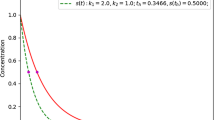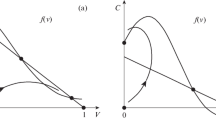Abstract
A hyperbolic reaction–diffusion model is developed in the framework of Extended Thermodynamics in order to describe the spatio-temporal dynamics of populations afflicted by chronic wasting diseases. The hyperbolic structure of the system guarantees that the wave processes occur at finite velocity, so that the paradox of instantaneous diffusion, typical of parabolic systems, is removed. The character of steady states, together with the Hopf bifurcation, are investigated through linear stability analysis. The model is integrated numerically to valuate the behavior of the populations. Finally, the propagation of acceleration waves is analyzed.





Similar content being viewed by others
Data availability statement
Not applicable.
References
Miller, M.W., Hobbs, N.T., Tavener, S.J.: Dynamics of prion disease transmission in mule deer. Ecol. Appl. 16(6), 2208–2214 (2006)
Sharp, A., Pastor, J.: Stable limit cycles and the paradox of enrichment in a model of chronic wasting disease. Ecol. Appl. 21(4), 1024–1030 (2011)
Barbera, E.: Mathematical models for diseases in wildlife populations with indirect transmission. Int. J. Biomath. 13(05), 2050042 (2020)
Hillen, T.: Hyperbolic model for chemosensitive movement. Math. Models Methods Appl. Sci. 12(7), 1007–1034 (2002)
Dumbar, S.R., Othmer, H.G.: On a nonlinear hyperbolic equation describing transmission lines, cell movement, and branching random walks. In: Othmer, H.G. (ed.) Nonlinear Oscillations in Biology and Chemistry. Lecture Notes in Biomathematics, vol. 66, pp. 274–289. Springer (1986)
Fort, J., Méndez, V.: Wavesfronts in time-delayed reaction–diffusion system. Theory and comparison to experiments. Rep. Progr. Phys. 65, 895–954 (2002)
Méndez, V., Campos, D., Horsthemke, W.: Growth and dispersal with inertia: hyperbolic reaction-transport systems. Phys. Rev. E 90, 042–114 (2014)
Müller, I., Ruggeri, T.: Rational Extended Thermodynamics. Springer, New York (1998)
Ruggeri, T., Sugiyama, M.: Rational Extended Thermodynamics Beyond the Monatomic Gas. Springer, New York (2015)
Ruggeri, T., Sugiyama, M.: Classical and Relativistic Rational Extended Thermodynamics of Gases. Springer, Berlin (2021)
Barbera, E., Consolo, G., Valenti, G.: A two or three compartments hyperbolic reaction–diffusion model for the aquatic food chain. Math. Biosci. Eng. 12(3), 451–472 (2015)
Barbera, E., Valenti, G.: Wave features of a hyperbolic reaction–diffusion model for chemotaxis. Wave Motion 78, 116–131 (2018)
Consolo, G., Grifó, G., Valenti, G.: Dryland vegetation pattern dynamics driven by inertial effects and secondary seed dispersal. Ecol. Model. 474, 110171 (2022)
Grifó, G., Consolo, G., Curró, C., Valenti, G.: Rhombic and hexagonal pattern formation in 2D hyperbolic reaction-transport systems in the context of dryland ecology. Phys. D Nonlinear Phenom. 449, 133745 (2023)
Barbera, E., Pollino, A.: An extended thermodynamics model for blood flow. Mathematics 10(16), 2977 (2022)
Barbera, E., Pollino, A.: A three-phase model for blood flow. Ric. Mat. (2023). https://doi.org/10.1007/s11587-023-00773-1
Brini, F., Seccia, L.: Acceleration waves and oscillating gas bubbles modelled by rational extended thermodynamics. Proc. R. Soc. A 478, 20220246 (2022)
Liu, I.S.: Method of Lagrange multipliers for exploitation of the entropy principle. Arch. Ration. Mech. Anal. 46, 131–148 (1972)
Boillat, G.: La propagation des ondes. Gauthier Villars, Paris (1975)
Acknowledgements
This research was funded by Indam (GNFM) and Prin Project: No. 2017YBKNCE “Multiscale phenomena in Continuum Mechanics: singular limits, off-equilibrium and transitions.
Part of this paper was presented in the Conference ”Wascom21”.
Author information
Authors and Affiliations
Corresponding author
Ethics declarations
Conflict of interest
On behalf of all authors, the corresponding author states that there is no conflict of interest.
Additional information
Publisher's Note
Springer Nature remains neutral with regard to jurisdictional claims in published maps and institutional affiliations.
Rights and permissions
Springer Nature or its licensor (e.g. a society or other partner) holds exclusive rights to this article under a publishing agreement with the author(s) or other rightsholder(s); author self-archiving of the accepted manuscript version of this article is solely governed by the terms of such publishing agreement and applicable law.
About this article
Cite this article
Barbera, E., Pollino, A. A hyperbolic reaction–diffusion model of chronic wasting disease. Ricerche mat (2023). https://doi.org/10.1007/s11587-023-00831-8
Received:
Accepted:
Published:
DOI: https://doi.org/10.1007/s11587-023-00831-8
Keywords
- Mathematical biology
- Reaction-diffusion models
- Diseases wildlife populations
- Indirect transmission
- Acceleration waves




